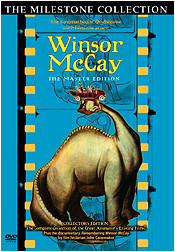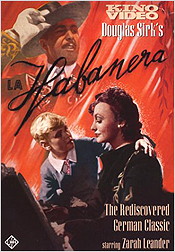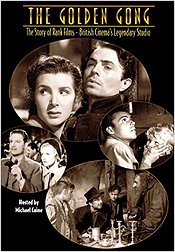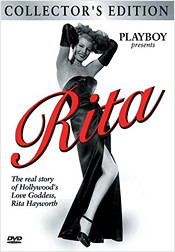 |
Site created 12/15/97.

page created: 8/23/04
 Barrie Maxwell - Main Page |
| Classic
Reviews Roundup #9 - August 2004 For this edition of the Classic Reviews Roundup, I have a number of off-beat items - a little something for everyone. We range from early animation (Winsor McCay, from Milestone/Image) to early German sound (La Habanera, from Kino) to a 1970s recreation of classic Hollywood (The Day of the Locust, from Paramount) and finally to various documentaries (Ronald Reagan, from CBS/Paramount; Rita, from Image; and The Golden Gong, from Shanachie). The reviews are arranged chronologically by year of original release. Winsor McCay: The Master Edition (1911-1921) (released on DVD by Milestone Film and Video on June 1st, 2004) Winsor McCay was a pioneer of animation. Most people will have seen at least snippets of his most famous creation, Gertie the Dinosaur, and probably recognize the characters from his first cartoon, Little Nemo, even if they don't associate them with the name, Winsor McCay. If the introductory segments of these two McCay cartoons are to be believed, he was somewhat of a gambling man as both of them indicate that they originated as a result of wagers with his friends. Some 4000 drawings were completed by him in a month in order to create Little Nemo and win his first wager, for example. George McManus, another contemporary cartoonist, was part of the second wager. Anyone familiar with McManus's Bringing Up Father will see flashes of similarity between his characters and those of McCay, although who was the influence on whom is hard to say. |
| Milestone's
DVD presents all the cartoons full frame as originally filmed and
with a high standard of image quality. For material some 80 to 90
years old, the clarity and sharpness is very good indeed. In the
case of Little Nemo, this can
be partially attributed to the use of the only known 35mm in
existence and for Gertie the Dinosaur,
to the National Archives of Canada's restoration using four 35mm
nitrate prints from the collection of the Cinémathèque
Québécoise. Certainly, all the cartoons exhibit
speckling and some debris, but in general, McCay fans should be very
happy with the quality exhibited. The music composed and played by
Gabriel Thibaudeau, and presented in stereo, is an excellent
complement to the animation. The disc's supplements consist of an
informative audio commentary by animation expert John Canemaker,
Canemaker's documentary Remembering
Winsor McCay which features one of McCay's assistants
(made in 1976, it's a little harsh sounding to the point of being
slightly hard to listen to at times), and a gallery of stills.
Overall, this is a very fine tribute to McCay and is recommended,
particularly to anyone with an interest in animation. La Habanera (1937) (released on DVD by Kino on March 30, 2004) This a German film from director Detlef Sierck, better known to North American audiences as Douglas Sirk. The film was produced at UFA, the German state-owned film monopoly that came increasingly under the direct control of the Propaganda Ministry of Joseph Goebbels after the Nazis came to power in 1933. By 1937, the level of control was virtually complete with all film criticism banned and a German film star system in place that would hopefully make all German films, even the outright propaganda ones, palatable to the German film-going public. The only competition came from American films imported by the German subsidiaries of the major American studios. With America's entry into the war in 1941, that competition ceased. |
| As
an early effort of Douglas Sirk's, the film exhibits many of the
characteristics that would distinguish Sirk's glossy Technicolor
melodramas of the 1950s for Universal - films such as Magnificent
Obsession and All That Heaven
Allows. Many of the scenes are composed with beauty and
complexity and Sirk uses interesting and fluid camera movement
throughout. Although La Habanera
is in black and white, its use of light and shadow almost seems to
make it glow in a way that foreshadows Sirk's later use of colour to
accentuate doomed characters locked in by the narrow-mindedness of
the social order of the time and place. The film's focus on a
character affluent in a material sense but starved emotionally and
sexually is a favourite Sirk theme. Even the bitter-sweet ending is
typical Sirk. Kino's DVD presents the film full frame in accord with the original aspect ratio. The image is merely average as classic releases go with noticeable softness at times and an occasional jitter in the picture. Speckling is present though not distracting. The image also has pronounced grain (which the disc packaging warns of). Despite these imperfections, the image is reasonably pleasant and does not distract from one's enjoyment of the film. The mono sound struck me as somewhat lacking in clarity for anyone trying to listen in German, although that may simply be due to my own lack of facility with the language. Optional English sub-titles are provided. The disc supplements include a four-page booklet essay by film scholar Jan-Christopher Horak providing historic context for the film's production, a Douglas Sirk filmography, a photo gallery, and excerpts from original German reviews. Recommended for all, but a must for Sirk fans. The Day of the Locust (1975) (released on DVD by Paramount on June 8th, 2004) With today's cult of celebrity, we're used to hearing about how it is to be successful in Hollywood, but what happens to all the people who have similar dreams and hopes that go unrealized? Director John Schlesinger took on Nathaniel West's 1939 novel about the seamy side of Hollywood, The Day of the Locust and turned out a remarkable portrait of that aspect of the then-glamorous film capital. The result is one further must-see film that came out of Hollywood's second golden age, the 1970s. The focus here is on the losers, the wannabes, and the has-beens, with major figures such as successful producers or directors only shown when they are exhibiting some failed character trait. The story follows the intertwined lives of a budding art director (Tod Hackett, played by William Atherton), a platinum blonde extra (Faye Greener, played by Karen Black), a terminally shy and repressed bookkeeper (Homer Simpson [before there were The Simpsons], played by Donald Sutherland), and a former vaudeville star turned door-to-door salesman (Harry Greener, Faye's father, played by Burgess Meredith). Mix in aspiring child actors, domineering mothers, madams and prostitutes, drunks, tough talking little people, cock fights, revival meetings and crowds of adoring fans at Hollywood premieres and you have a graphic, sometimes unpleasant, but always fascinating portrait of what you generally don't read about in film books. |
| Paramount's
DVD presentation is up to its usual high standard. The 1.85:1
anamorphic transfer is very crisp and clean with fine shadow detail
and no edge effects. Only the occasional speckle and some very minor
debris mar the overall effect. The film's subdued colours are
properly rendered. A new Dolby Digital 5.1 surround track provides a
very pleasing experience characterized by subtle use of the
surrounds for background effects. John Barry's enjoyable score has
nice presence. The original mono track is also included as are
English sub-titles. There are no supplements. Recommended. The Golden Gong: The Story of Rank Films - British Cinema's Legendary Studio (1987) (released on DVD by Shanachie on June 8th, 2004) The latest release in Shanachie's British Cinema Collection is a fairly decent documentary on the films that were produced by the J. Arthur Rank organization at its Pinewood Studios. It runs a brisk 76 minutes and is breezily narrated by Michael Caine. The documentary approach used is fairly standard as Caine takes us through the history of Rank Films in a chronological fashion, touching on the highlights of the organization's first 50 years. Film clips and interviews with film historian Peter Noble and many of the actors and directors who were responsible for the films are used extensively. The range of cast and crew interviewed is impressive, for example, producer Albert "Cubby" Broccoli, directors David Lean, Michael Powell, and Ronald Neame, and actors John Mills, Richard Attenborough, Dirk Bogarde, Stewart Granger, Christopher Reeve, Kenneth Connor, Joan Sims, Joan Collins, and Diana Dors. |
| Shanachie's
release is presented full frame and echoes the quality of most
recent documentaries made available on DVD. The new material shot
looks quite crisp and clean, while the archival material is variable
in quality. The stereo sound is effective with some slight
directionality evident across the front stage. No sub-titling is
provided. The disc has no supplements. The disc is worth viewing for
those looking for an introduction to the Rank films. All others
should seek out a good written history such as Geoffrey MacNab's
J. Arthur Rank and the British Film
Industry. Ronald Reagan: His Life and Legacy (2002) (released on DVD by Paramount on June 22nd, 2004) In the wake of the recent death of former actor and U.S. president, Ronald Reagan, we're starting to see a number of filmed tributes and biographies appearing. I include consideration of one such of these discs here because of Reagan's film background and the possibility that someone may be considering its purchase in hopes of getting some detail on his film career. |
| Paramount's
DVD, distributed on behalf of CBS, provides a crisp, clear full
frame presentation and clear stereo sound (no sub-titling provided).
It's no less than one would expect for such recent material. The
disc's supplements include unabridged audio-only presentations of
the Reagan speeches and a short featurette (appropriately called
The Great Communicator)
dealing with Reagan's communications abilities as seen through the
eyes of his former speech-writer. The disc quality is fine;
unfortunately the content doesn't merit a purchase. Rita/Trouble in Texas: Collector's Edition (2004/1937) (released on DVD by Playboy/Image Entertainment on June 15th, 2004) Anyone who loves classic films knows about Turner Classic Movies (TCM) and anyone who watches TCM is aware of their original productions that provide profiles of stars of the Golden Age. One of those recent profiles, entitled Rita, focused on the life of Rita Hayworth and was produced in conjunction with Hugh Hefner and Playboy Enterprises. Rita is a 58-minute program narrated by Kim Basinger that covers the Columbia star's film career in reasonable detail and her later life that fell increasingly under the shadow of Alzheimer's Disease. The program is a mixture of film clips (though not enough of them), personal home movies, rare out-takes, and interviews with the likes of Hayworth's daughter Princess Yasmin Aga Khan, Ann Miller, Tab Hunter, Tony Franciosa, Juanita Moore, Eli Wallach, Marc Platt, Vincent Sherman, George Sidney, and Delbert Mann. Basinger's narration that ties it all together is delivered in a rather flat voice. The profile is definitely revealing and worth watching, although it does leave you vaguely unsatisfied because it doesn't convey as much warmth and enthusiasm for the subject as she warrants. |
| During
the first part of her film career, extending from 1935 to 1937, Rita
was billed under her real name, Rita Cansino. One of the last films
from that time was 1937's Trouble in
Texas, a Tex Ritter western produced by independent Grand
National Pictures. Rita was second-billed and played an undercover
agent who teams up with Ritter to investigate a series of rodeo
prize money robberies. The film was at best an average B-western
entry for the time, although it did contribute to Ritter becoming
one of the top five western box-office stars soon thereafter. Image
has included the film on the second disc of its Rita
set. Unfortunately the print used is in pretty rough shape. It's
watchable, but suffers from a washed-out appearance, dropped frames,
occasionally fuzzy dialogue, and a blizzard of speckles and debris
at times. The original Grand National main titles are missing on the
source print used, having been replaced by a later distributor to
attribute top billing to Rita Hayworth. Despite my vague disquiet over the documentary itself and the limited quality of Trouble in Texas, this is a package worth having for any Rita Hayworth fan. Barrie Maxwell barriemaxwell@thedigitalbits.com |
Barrie Maxwell - Main Page
 |
| Site
designed for 1024 x 768 resolution, using 16M colors and .gif 89a
animation. © 1997-2015 The Digital Bits, Inc., All Rights Reserved. billhunt@thedigitalbits.com |





